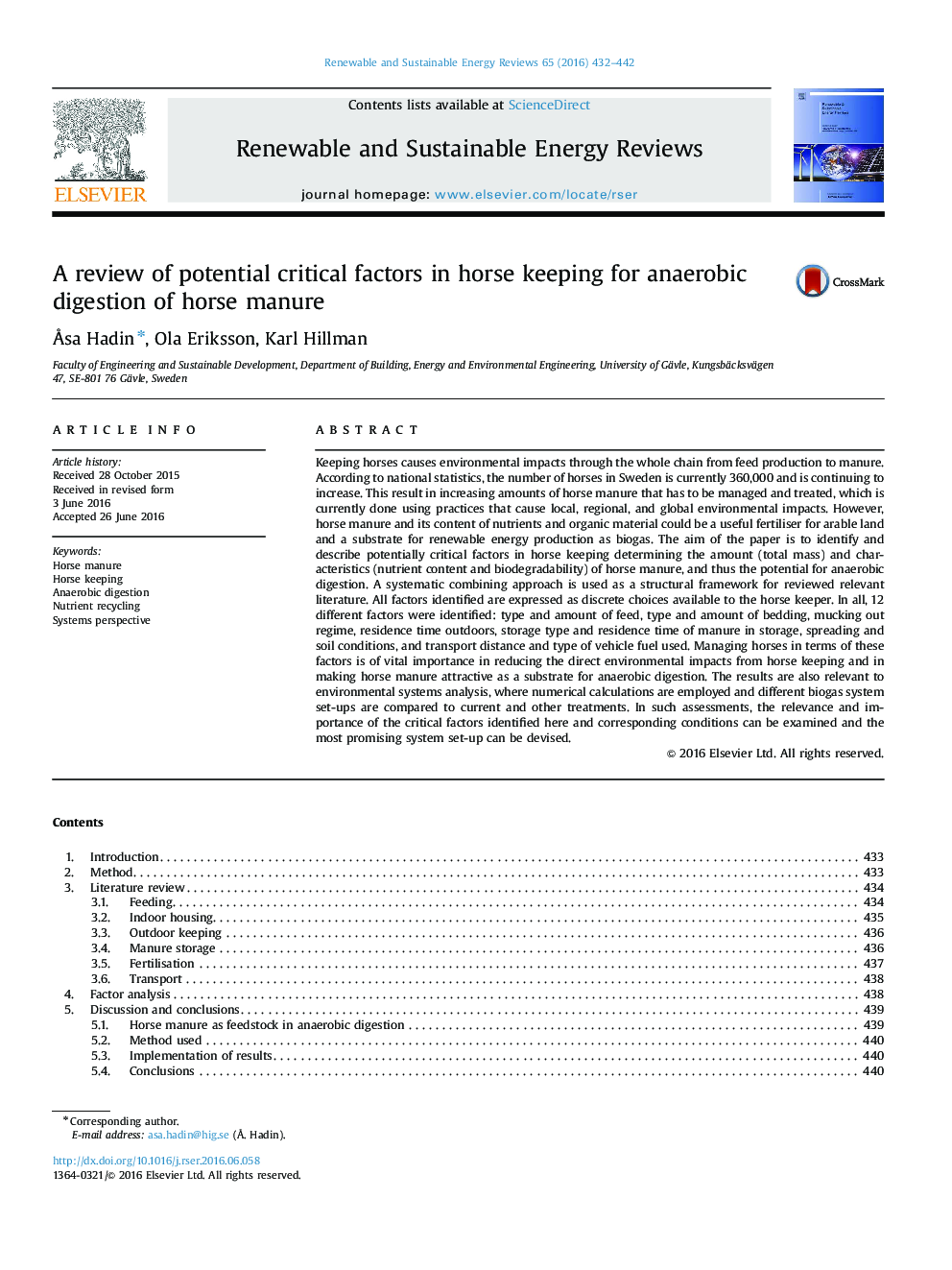| کد مقاله | کد نشریه | سال انتشار | مقاله انگلیسی | نسخه تمام متن |
|---|---|---|---|---|
| 8112838 | 1522320 | 2016 | 11 صفحه PDF | دانلود رایگان |
عنوان انگلیسی مقاله ISI
A review of potential critical factors in horse keeping for anaerobic digestion of horse manure
ترجمه فارسی عنوان
بررسی عوامل مهم بالقوه نگهداری اسب برای هضم بی هوازی کود حیوانی اسب
دانلود مقاله + سفارش ترجمه
دانلود مقاله ISI انگلیسی
رایگان برای ایرانیان
کلمات کلیدی
کود اسب، اسب نگهداری، هضم بی هوازی بازیافت مواد مغذی، چشم انداز سیستم،
ترجمه چکیده
نگه داشتن اسب باعث ایجاد اثرات زیست محیطی از طریق کل زنجیره ای از تولید مواد غذایی به کود می شود. طبق آمار ملی، تعداد اسب ها در سوئد در حال حاضر 360،000 نفر است و همچنان افزایش می یابد. این نتیجه در افزایش مقدار کود از اسب است که باید مدیریت و درمان شود، که در حال حاضر با استفاده از شیوه هایی که موجب اثرات زیست محیطی محلی، منطقه ای و جهانی می شود، انجام می شود. با این حال، کود نان سوخاری و محتوای آن از مواد مغذی و مواد آلی می تواند مفید کود برای زمین های زراعی و زیرزمینی برای تولید انرژی تجدیدپذیر به عنوان بیوگاز باشد. هدف مقاله شناسایی و توصیف عوامل بالقوه بحرانی در حفظ اسب است که تعیین مقدار (توده کل) و ویژگی (محتوی مواد مغذی و تجزیه زیستی) کود نیشکر و در نتیجه پتانسیل هضم بی هوازی است. رویکرد ترکیبی سیستماتیک به عنوان یک چارچوب سازمانی برای بررسی ادبیات مربوطه مورد استفاده قرار می گیرد. تمام عوامل شناسایی شده به عنوان گزینه های گسسته در دسترس برای نگهبان اسب بیان می شود. در مجموع 12 عامل مختلف شناسایی شدند: نوع و میزان خوراک، نوع و میزان بستر، رژیم غذایی، زمان اقامت خارج از منزل، نوع ذخیره سازی و زمان اقامت کود در ذخیره سازی، پخش و شرایط خاک، فاصله حمل و نقل و نوع سوخت خودرو استفاده می شود. مدیریت اسب ها از نظر این عوامل اهمیت حیاتی در کاهش اثرات مستقیم زیست محیطی از نگهداری اسب و ایجاد جذابیت اسب به عنوان بستر برای هضم بی هوازی است. نتایج نیز مربوط به تجزیه و تحلیل سیستم های محیط زیست، که در آن محاسبات عددی مورد استفاده قرار می گیرند و تنظیمات سیستم های مختلف بیوگاز با روش های فعلی و دیگر مقایسه می شود. در چنین ارزیابی ها، اهمیت و اهمیت فاکتورهای بحرانی تعیین شده در اینجا و شرایط مربوطه می تواند مورد بررسی قرار گیرد و بیشترین چالش راه اندازی سیستم را می توان به دست آورد.
موضوعات مرتبط
مهندسی و علوم پایه
مهندسی انرژی
انرژی های تجدید پذیر، توسعه پایدار و محیط زیست
چکیده انگلیسی
Keeping horses causes environmental impacts through the whole chain from feed production to manure. According to national statistics, the number of horses in Sweden is currently 360,000 and is continuing to increase. This result in increasing amounts of horse manure that has to be managed and treated, which is currently done using practices that cause local, regional, and global environmental impacts. However, horse manure and its content of nutrients and organic material could be a useful fertiliser for arable land and a substrate for renewable energy production as biogas. The aim of the paper is to identify and describe potentially critical factors in horse keeping determining the amount (total mass) and characteristics (nutrient content and biodegradability) of horse manure, and thus the potential for anaerobic digestion. A systematic combining approach is used as a structural framework for reviewed relevant literature. All factors identified are expressed as discrete choices available to the horse keeper. In all, 12 different factors were identified: type and amount of feed, type and amount of bedding, mucking out regime, residence time outdoors, storage type and residence time of manure in storage, spreading and soil conditions, and transport distance and type of vehicle fuel used. Managing horses in terms of these factors is of vital importance in reducing the direct environmental impacts from horse keeping and in making horse manure attractive as a substrate for anaerobic digestion. The results are also relevant to environmental systems analysis, where numerical calculations are employed and different biogas system set-ups are compared to current and other treatments. In such assessments, the relevance and importance of the critical factors identified here and corresponding conditions can be examined and the most promising system set-up can be devised.
ناشر
Database: Elsevier - ScienceDirect (ساینس دایرکت)
Journal: Renewable and Sustainable Energy Reviews - Volume 65, November 2016, Pages 432-442
Journal: Renewable and Sustainable Energy Reviews - Volume 65, November 2016, Pages 432-442
نویسندگان
Ã
sa Hadin, Ola Eriksson, Karl Hillman,
